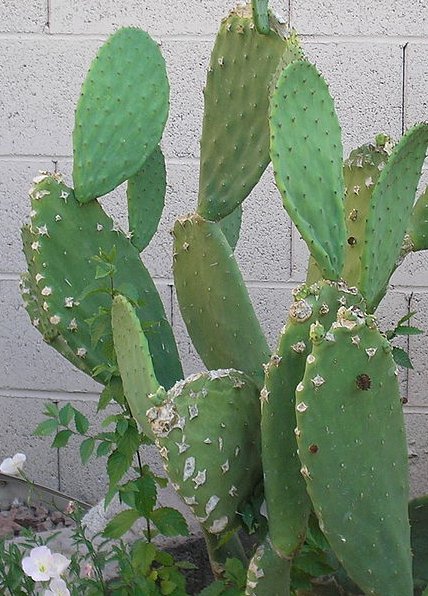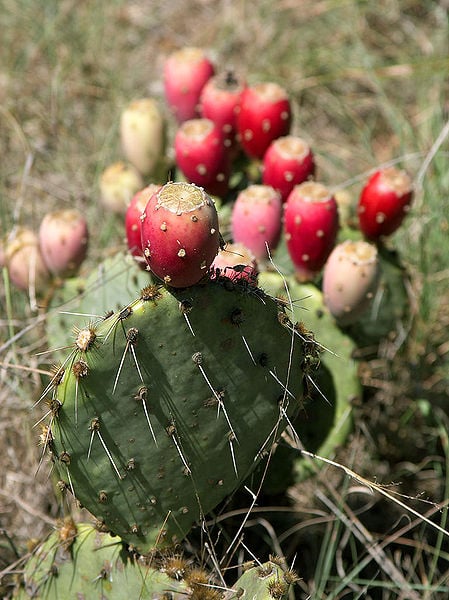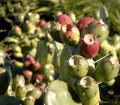What Are the Benefits of the Prickly Pear Cactus
Where did Opuntia Originate
First Prickly Pear is officially named Indian Fig Opuntia. In Mexico it is called Nopales which is derived from the Aztec name nōpalli. In the Aztec language nōpalli means "pads." Other names are Cactus Fig, Indian Fig, and Tuna.
Tuna refers to the fruit growing from the rim of the paddle of the cactus. This fruit is used in Mexico to make Aquas Frescas (fresh [cold] waters) . The fruit can be red, wine-red, burgundy, or yellow. (see photo 2).
Opuntia is native to Mexico. It is such an old plant that no one is certain when humans first started using them as food. It is known that the Aztec people used it extensively.
Cleaning Opuntia
Spines
There are two types of spines on the paddle shaped leaves. A fixed hard spine that is quite sharp and a very fine almost transparent spine. The heavier spine (brown to black in color) will stay on the leaf of the plant while the finer spine breaks off easily and can become embedded in the skin.
Of course if this plant is to be used as food or medicinally these spines need to be removed. Spines can be cut off with a knife, sanded off (early American cultures rolled them around in lose sand), or burned off with an open flame. It is highly recommended that gloves be used in all cases when removing spines.


Opuntia as Medicine / Cosmetic
Opuntia are high in alkaloids. Early herbal uses of Opuntia included the treatment of Type II diabetes and stomach ache. Like Aloe Vera, there is no solid scientific evidence that Opuntia is effective in treating these two ailments, but that is primarly because such studies have not been conducted.
Animal studies indicate that both diabetes (Type II) and stomach ailments can be treated with Opuntia, but human studies have just begun with mixed results.
Hangover Relief
Indian Fig (the most common nopale) may help reduce the effects of hangover by inhibiting inflammation. Some studies (though not all) have shown the effects of reduced nausea, loss of appetite, and dry-mouth.
Hair Conditioner
The sap of the Opuntia paddle has been used as an effective hair conditioner.
Opuntia as Food / Drink
Alcoholic Drink
Opuntia sap has been used for thousands of years in what is now Mexico as an ingredient in an alcoholic drink called colonche.
Candies and Jellies
The "fig" or tuna (see picture 2) are used to make both candies and jellies.
Nopales
The young paddle, cleaned of spines, sliced and pan cooked, is used as an ingredient in breakfasts and mid-day or evening meals. The sliced and cooked paddle is called nopales.
Nopales Salad
Ingredients
- 1 1/2 pound Opuntia paddles (these should be young and bright green)
- 3/4 Cup olive oil
- 4 roma tomatoes
- 1 small onion (red, white, or yellow)
- 1 or 2 serrano chili peppers
- 2 bunches cilantro (Mexican parsley)
- 1/2 Cup grated Cotija or Anejo cheese
- 1/2 Cup red-wine vinegar
Directions
- Preheat grill or broiler
- Remove all the spines with a knife. This may require simply "scaling" them or cutting them off. You do not want to eat the spines
- Place "de-spined" paddles in a large bowl and toss to coat evenly with
1/4 cup of the olive oil and 1/2 teaspoon of the salt
- Grill or broil
the paddles until grill marks appear on each side, or they turn dark
green with black patches. This should take about 3 to 5 minutes
- Set aside to cool to
room temperature
- Cover and chill 2 to 4 hours or overnight
- Cut cactus into 1/4 to 1/2-inch strips
- Cube your tomatoes, onions, and chilis
- Roll the cilantro leaves into a tube (a bunch at a time) and slice into 1/4 to 1/2 inch strips
- Break up the cheese or grate it as necessary. Either way you want crumbles.
- Combine the nopales (sliced cactus), tomatoes,
onions, chilies, cilantro and cheese with the remaining 1/2 cup oil, the
vinegar, the remaining 1 teaspoon salt and pepper in a large bowl
- Toss well
- Serve on plates lined with lettuce leaves, and garnish with avocado slices
Nopales con Huevos
Cactus with Egg
Ingredients
- 1 lb (a single paddle) Opuntia
- 1 Tablespoon oil
- 2 Tomatoes, diced
- 1 Cloves garlic, peeled and crushed
- 1/2 white onion, diced
- 4 Serrano peppers, peeled (seeded?) and diced
- 2 Large eggs
Remove the seeds from the Serrano for less heat; or simply use fewer of these chilies.
Directions
- Clean the cactus paddle to remove the spines. A knife or vegetable peeler works well. Be sure to wear gloves. Also, remove the base of the cactus paddle. This is pretty tough.
- Cut the cactus into thin 1/4" to 1/8" strips. You now have nopales.
- Cook the nopales in boiling water for ten to twenty minutes or until fork tender
- Once cooked cool the nopales in cold water and set aside
- Heat a skillet or cast iron pan to medium heat
- Toss into the pan all the ingredients except the eggs. Cook until the ingredients are somewhat dry. Remove the lid to cause some of the moisture to evaporate if necessary.
- Break the eggs into the mixture and stir rapidly to set the eggs
Delicious. Makes two servings. Of course you can prepare the nopales in advance and add them when needed. They should keep in the refrigerator for about a week if kept in an airtight container.
I've heard time and time again how much they taste like green-beans. I don't completely agree. They have a mildly "earthy" flavor. What I find most interesting is no matter how long you cook nopales they have a decided "snap" when you bite them. Love the texture. And the mildly earthy flavor is a great counter-point to the spicy pepper.
Prickly Pear Jelly
Ingredients
- 2 1/2 Cups prickly pear juice (see directions)
- 3 Tablespoons lemon or lime juice
- 1 package powdered pectin
- 3 1/2 Cups sugar
Directions
-
One quart of prickly pear cactus fruit should make about 2 1/2 cups of
juice. Pluck the fruit from the cactus with a long-handled fork or
tongs.
- Wash under running water, then using the method in the video above remove the rind. It is not necessary to remove the seeds for this recipe.
- Steam until fruit is fork tender and soft.
- Mash and strain
using a jelly bag or fine sieve. Do not add water.
- Set aside to allow juice to settle. You can use all of the juice or strain off the clear liquid for a clear jelly. I favor using all the juice including the sediment.
- Measure 2 1/2 Cups of juice into a saucepan.
- Add the powdered pectin and stir.
- Bring mixture to a hard while constantly stirring.
- Now add
lemon or lime juice and sugar.
- Return to a fast boil (one that cannot be
stirred down with a spoon) and let boil for 3 more minutes; no more.
- Remove from heat, skim
and pour into hot canning jars leaving 1/4 inch space at the top per jar.
- Wipe jar rims and seal lids. Process for 10 minutes in a boiling water bath. Makes 6 1/2 pints of jelly.










